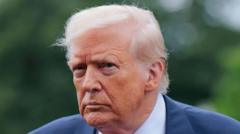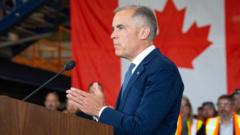President Donald Trump has ramped up tariffs on steel and aluminium imports from 25% to 50%, asserting the need to secure the US steel industry. While the order aims to bolster domestic production, it raises concerns about retaliation from trade partners and increased costs for American manufacturers.
US Doubling of Steel and Aluminium Tariffs Sparks Trade Tensions

US Doubling of Steel and Aluminium Tariffs Sparks Trade Tensions
President Trump signs an order increasing tariffs on steel and aluminium imports to 50%, aimed at protecting the American steel industry, but critics warn of negative repercussions on global trade.
In a bold move concerning trade, President Donald Trump has signed an order that will see tariffs on imported steel and aluminium soar from 25% to a staggering 50%. The newly increased rates, which will take effect on Wednesday, mark the second tariff hike since the measures were originally introduced in March, signaling Trump's continued push to safeguard the American steel industry.
Trump argues that these escalating duties are essential to protect a vital sector of the national economy. However, experts and critics express grave concerns that the high tariffs could disrupt global supply chains, provoke countermeasures from affected trading partners, and ultimately inflate prices for consumers and businesses reliant on these metals for production—a significant input not just for construction but also for automotive and food packaging industries.
The decision has left many firms, especially those dependent on importing steel, in disbelief. Hours before the official announcement, there was speculation that the proposed plan might be a negotiating tactic rather than a long-term alteration. Rick Huether, CEO of Independent Can Co., highlighted his uncertainty and frustration, emphasizing how the abrupt policy shifts can prompt customers to seek alternative materials like plastic.
Statistically, the US remains the world’s largest steel importer, after the European Union, sourcing the bulk of its steel from Canada, Brazil, Mexico, and South Korea. During his presidency, Trump previously imposed tariffs of 25% on steel and 10% on aluminium under national security legislation. However, various importers managed to sidestep these tariffs thanks to negotiated exceptions and trade deals established with allied nations.
In response to growing dissatisfaction with the effects of these protectionist policies, Trump declared the end of these exemptions in March, asserting that they undermined his initial intentions for robust trade protections. He reaffirmed his commitment to a high tariff strategy during a recent rally, emphasizing that the steep tariffs would compel US businesses to source domestically, thereby shielding the industry from foreign competition.
Meanwhile, repercussions are already being felt internationally. Amid the announcement, the UK was exempted from these new tariffs, maintaining its steel and aluminium rates at 25% as negotiations continue with the US government. Trade Secretary Jonathan Reynolds expressed relief that the UK could avoid the latest increases, but warned that the situation still calls for urgent attention in the ongoing trade discussions.
In the wider European context, Germany and Canada are preparing retaliatory tariffs, fueling fears of escalating trade wars. Notably, the American Iron and Steel Institute reported little change in the nation’s steel import volumes since earlier increases, although a marked 17% drop in imports was observed for April compared to March.
Economist analyses have consistently highlighted the negative economic impact of tariffs, suggesting they could stifle job growth, particularly in sectors influenced by steel prices. A 2020 report indicated that while Trump's tariffs may have created some jobs in the steel industry, they resulted in a net loss of approximately 75,000 jobs across other sectors.
As small manufacturers like Chad Bartusek's Drill Rod & Tool Steels face dramatic spikes in costs—nearly doubling their expected tariff expenditures—it becomes clear that the new tariffs could inflict significant harm on American businesses and consumers alike. The uncertain future looms large, as many in the industry hope for a rapid stabilization of the trade climate.




















